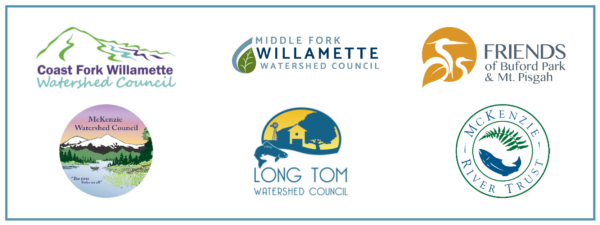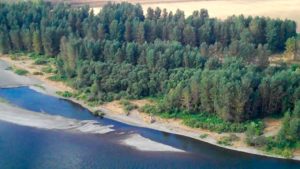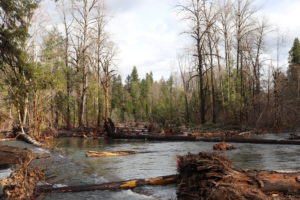Upper Willamette Stewardship Network
What is the Upper Willamette Stewardship Network?

We work with communities to care for land and water in the Upper Willamette
After two years of exploratory meetings, Executive Directors from four watershed councils, a land trust, and a conservation nonprofit launched the Upper Willamette Stewardship Network (UWSN) in 2018. Through this collaborative effort, network members are working to improve and expand programs, increase cost effectiveness, eliminate duplication of efforts, and achieve long-term organizational stability to serve the region’s land and water resources and its communities. It is understood that there will be an initial investment phase to build awareness and trust, identify opportunities, and determine how to best partner on shared programming and initiatives.
Organizations participating in the network include the Coast Fork Willamette Watershed Council, Friends of Buford Park and Mount Pisgah, Long Tom Watershed Council, McKenzie Watershed Council, McKenzie River Trust, and Middle Fork Willamette Watershed Council.
WHY
 Anyone who has worked with land and water resources knows that Nature functions without regard for jurisdictional boundaries. As a result, effective regional stewardship only happens through the efforts of multiple individuals, organizations, and agencies, and by addressing not only biological and ecological factors, but social, political, and economic factors as well.
Anyone who has worked with land and water resources knows that Nature functions without regard for jurisdictional boundaries. As a result, effective regional stewardship only happens through the efforts of multiple individuals, organizations, and agencies, and by addressing not only biological and ecological factors, but social, political, and economic factors as well.
Many of the organizations were active participants in the Willamette River Initiative, which was instrumental in bringing together numerous partners across a larger geography to work collectively toward a healthy Willamette River. The work of the Network’s members has become increasingly collaborative. Member organizations already partner with each other – as well as with public agencies, landowners, and other community organizations – on projects and long-term programs to increase conservation outcomes and community benefits. Examples of recent collaborations include the hiring of a fulltime Network Coordinator, several successful joint grant proposals, a new regional initiative for stormwater management, a regional environmental education planning team, hosting the Wild & Scenic Film Festival, and increased sharing of resources and expertise across a wide range of program areas from restoration projects to fiscal management.
Funding for conservation and stewardship requires a collaborative approach. Foundations and funding agencies increasingly expect conservation organizations to submit joint grant proposals and work together to achieve shared outcomes. An intention of the Network is to “grow the pie” – by joining forces across a larger geography and putting collaboration over competition, we hope to leverage additional resources to fund our work.
WHAT
Network members have identified the following opportunities for productive collaboration:
- Increased revenue generation
- Engagement with a diverse range of communities
- Outdoor and environmental education
- Habitat restoration projects where overlapping expertise and geographies align
- More effective and sustained land stewardship and conservation efforts at the regional scale
- Shared staff and equipment
HOW
 The Upper Willamette Stewardship Network is designed for two levels of participation. Network Members, consisting of organizations that have committed to advancing the network’s goals, will define the network’s agenda and benefit from closer working relationships with other members.
The Upper Willamette Stewardship Network is designed for two levels of participation. Network Members, consisting of organizations that have committed to advancing the network’s goals, will define the network’s agenda and benefit from closer working relationships with other members.
A second tier of network participation is the collaboration of Network Members with Active Partners. Active Partners are organizations that are working in the same programmatic areas and with similar goals, but that aren’t specifically committed to the network itself, such as other nonprofits and federal, state, county, and municipal agencies.
Executive Directors from each member organization serve as the Network’s Core Team, which meets for a half day in person each month and regularly via video conference and a shared messaging platform to share information, advance the Network’s goals and implement related activities, and make decisions about the Network’s evolution.
In addition to the Core Team, there are several Project Teams that meet regularly to work on regional planning and programming related to outreach & communications, environmental education, administrative and fiscal management, restoration & stewardship, and diversity, equity & inclusion.
The Network Coordinator, with support from the Executive Directors, is responsible for coordinating the activities of the Network, planning and facilitating meetings, budgeting, internal communications and public relations.
UWSN Members
Coast Fork Willamette Watershed Council Our mission is to enhance the Coast Fork Willamette Watershed through restoration, monitoring, education and stewardship.
Friends of Buford Park and Mt. Pisgah Our mission is to protect and enhance native ecosystems and compatible recreation in the Mt. Pisgah area.
Long Tom Watershed Council Serves to improve water quality and watershed condition in the Long Tom River Basin and surrounding drainages through education and collaboration among all interests, using the collective wisdom and voluntary action of our community members.
McKenzie River Trust Helps people protect and care for the lands and rivers they cherish in western Oregon.
McKenzie Watershed Council Our mission is to foster better stewardship of the McKenzie River watershed resources, deal with issues in advance of resource degradation, and ensure sustainable watershed health, function, and use.
Middle Fork Willamette Watershed Council We work with communities for a healthy Middle Fork Willamette watershed through environmental education and habitat restoration.